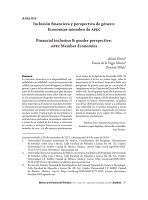Financial inclusion & gender perspective: APEC Member Economies
DOI:
https://doi.org/10.32870/mycp.v7i21.562Keywords:
Microfinance, Digital Payments, Sustainable Development, Asia PacificAbstract
Financial inclusion is the availability, affordability and accessibility of financial services, regardless of the level of income, location or gender. Despite the efforts and commitments of the international community to reach this state, there are still challenges, especially regarding the incorporation of minority groups and the transition to sustainable financial systems. Therefore, it is important to include a gender perspective in the economic and financial analysis because women face more barriers to access and be part of the benefits and opportunities of the financial system. The following text seeks to clarify the previous premises through an analysis of the advances or setbacks in terms of financial inclusion in APEC member economies and if this positively influences the progress of the Agenda 2030. In the first section, it contextualizes the reader on financial inclusion, why it is important from a gender perspective and why it is crucial for the fulfillment of the Sustainable Development Goals (SDGs). The following section presents statistical evidence on financial services in the countries of the region to identify achievements and blank spaces. Subsequently, is analyzed one of the alternatives to include the most vulnerable population in the financial system microfinance, and the advances of the region are shown in a series of good practices. Finally, is indicated a section of conclusions.Downloads
References
Asia Pacific Economic Cooperation. (2017). The apec Women and The Economy
Dashboard 2017. Recuperado de
https://www.apec.org/Publications/2017/09/The-apec-Women-and-The-Economy-Dashboard-2017
Banco Mundial. (2014). Global Financial Development Report 2014: Financial
Inclusion. Washington, D. C.: World Bank. Recuperado de https://openknowledge.worldbank.org/handle/10986/16238
Banco Mundial. (2016). Contexto Inclusión financiera. Recuperado de http://
www.bancomundial.org/es/topic/financialinclusion/overview
Bateman, M. & Chang, H. (2012). Microfinance and the Illusion of Development: From Hubris to Nemesis in Thirty Years. World Economic Review. 1, 13-36.
Comisión Económica para América Latina y el Caribe. (2016a). Autonomía de las mujeres e igualdad en la agenda de desarrollo sostenible. Santiago: Naciones Unidas.
Comisión Económica para América Latina y el Caribe. (2016b). Estudio Económico de América Latina y el Caribe 2016: La Agenda 2030 para el Desarrollo Sostenible y los desafíos del financiamiento para el desarrollo. Santiago: Naciones Unidas. Recuperado de https://www.cepal.org/es/publicaciones/estudio-economico-america-latina-caribe-2016-la-agenda2030-desarrollo-sostenible
Consultative Group to Assist the Poor. (2017). Financial Inclusion. Microfinancegateway. Recuperado de http://www.cgap.org/topics/financial-inclusion
Economist Intelligence Unit. (2016). Microscopio global 2016: Análisis del entorno para
la inclusión financiera. New York, NY: Patrocinado por el FOMIN/BID, Acción y la Fundación MetLife. EIU. Recuperado de https://publications.iadb.org/handle/11319/7988?locale-attribute=es&locale-attribute=en
Global Banking Alliance for Women, Data2X & Multilateral Investment Fund of the Inter-American Development Bank. (2015). Measuring Women´s Financial Inclusion: The value of sex-disaggregated data. Recuperado de http://www.gbaforwomen.org/download/draft-report-measuringwomens-financial-inclusion/
International Monetary Fund. (2016). Financial Access Survey. Recuperado
De http://data.imf.org/?sk=E5DCAB7E-A5CA-4892-A6EA598B5463A34C&sId=1390030341854
Klapper, L. (2012). Gender Barriers to Banking Exist Worldwide. (Gallup). Recuperado de http://news.gallup.com/poll/156122/gender-barriersbanking-exist-worldwide.aspx
Klapper, L. & Hess, J. (2016). Financial Inclusion and Women´s Economic Empowerment.
A Briefing for the UN Secretary-General´s High-Level Panel on Women´s Economic Empowerment. The World Bank, Development Research Group. Finance & Private Sector Development Team.
Klapper, L. & Singer, D. (8 de septiembre de 2016). Moving toward financial inclusion in East Asia and the Pacific. [Comentario del blog All About Finance]. Recuperado de http://blogs.worldbank.org/allaboutfinance/moving-toward-financial-inclusion-east-asia-and-pacific
MIX Market. (2014). Global Outreach & Financial. Performance Benchmark Report-2014. Recuperado de http://www.themix.org/mixmarket/publications/2014-global-outreach-and-financial-performance-benchmark-report
Organisation for Economic Cooperation and Development. (2016). Starting a business. (indicator). doi: 10.1787/a22da914-en
Powell, J. (2013). El sub-financiamiento y la financiarización en México: ¿Paradoja mexicana o una parábola de economías con ingreso medio? En N. Levy & T. López (Eds.), Financiarización y modelo de acumulación. Aportes desde los países en desarrollo (pp. 261-290). México: UNAM.
Standard & Poor’s. (2014). Financial Literacy Around the World. Insights from the Standard & Poor’s Ratings services global financial Literacy survey. Recuperado de https://www.finlit.es/informe-sp-2014-financial-literacyaround-the-world/
Tafur, C. (2009). Bancarización: Una aproximación al caso colombiano a la luz de América Latina. Estudios Gerenciales, 25(110), 13-37.
Thirlwall, A. (2011). Financing Development from Domestic Resources. En A.P. Thirlwall & P. Pacheco-López, Economics of Development: Theory and Evidence (9 ed., pp.385-436). UK: Palgrave Macmillan.
UN High Level Panel for Women’s Economic Empowerment. (2016). Leave No One Behind, A Call to Action for Gender Equality and Women’s Economic Empowerment. Recuperado de http://www2.unwomen.org/-/media/hlp%20wee/attachments/reports-toolkits/hlp-wee-report-2016-09-callto-action-en.pdf?la=en&vs=1028
World Bank (2016). Global Financial Inclusion Database [Datos estadísticos]. Recuperado de http://datatopics.worldbank.org/gender/

Downloads
Published
How to Cite
Issue
Section
License
Open Access Policy
This journal provides open access to all its contents, in adherence to the principle that making research freely available supports a greater global exchange of knowledge.
MyCP is licensed under a Creative Commons Attribution-NonCommercial license, also known as CC BY-NC.
Contents are published in both PDF and XML formats.
Authors who publish in México y la Cuenca del Pacífico must accept the following conditions:
Pursuant to Mexican copyright laws, México y la Cuenca del Pacífico acknowledges and respects the authors’ moral right and ownership of property rights, which will be assigned to the University of Guadalajara to publish the articles in an open-access mode.
México y la Cuenca del Pacífico does not charge the authors any fees for receiving and processing their articles.
Authors are permitted to enter into other independent and additional contractual agreements for the non-exclusive distribution of the article version published in México y la Cuenca del Pacífico (for example, publishing it in an institutional repository or in other printed or electronic media) as long as they clearly state that the piece was originally published in México y la Cuenca del Pacífico.
Pursuant to the above, once the article is approved for publication, authors must send the Assignment of Rights Agreement form duly filled and signed. This form must be sent to mexicoylacuenca@gmail.com as a PDF file.
Readers/users of México y la Cuenca del Pacífico can freely access the journal new issues as soon as they are uploaded. Readers/users are allowed to cite, share (both electronically and physically), print and distribute the material, provided they expressly state that the work was originally published in México y la Cuenca del Pacífico. Contents are to be properly cited and never for commercial purposes.




